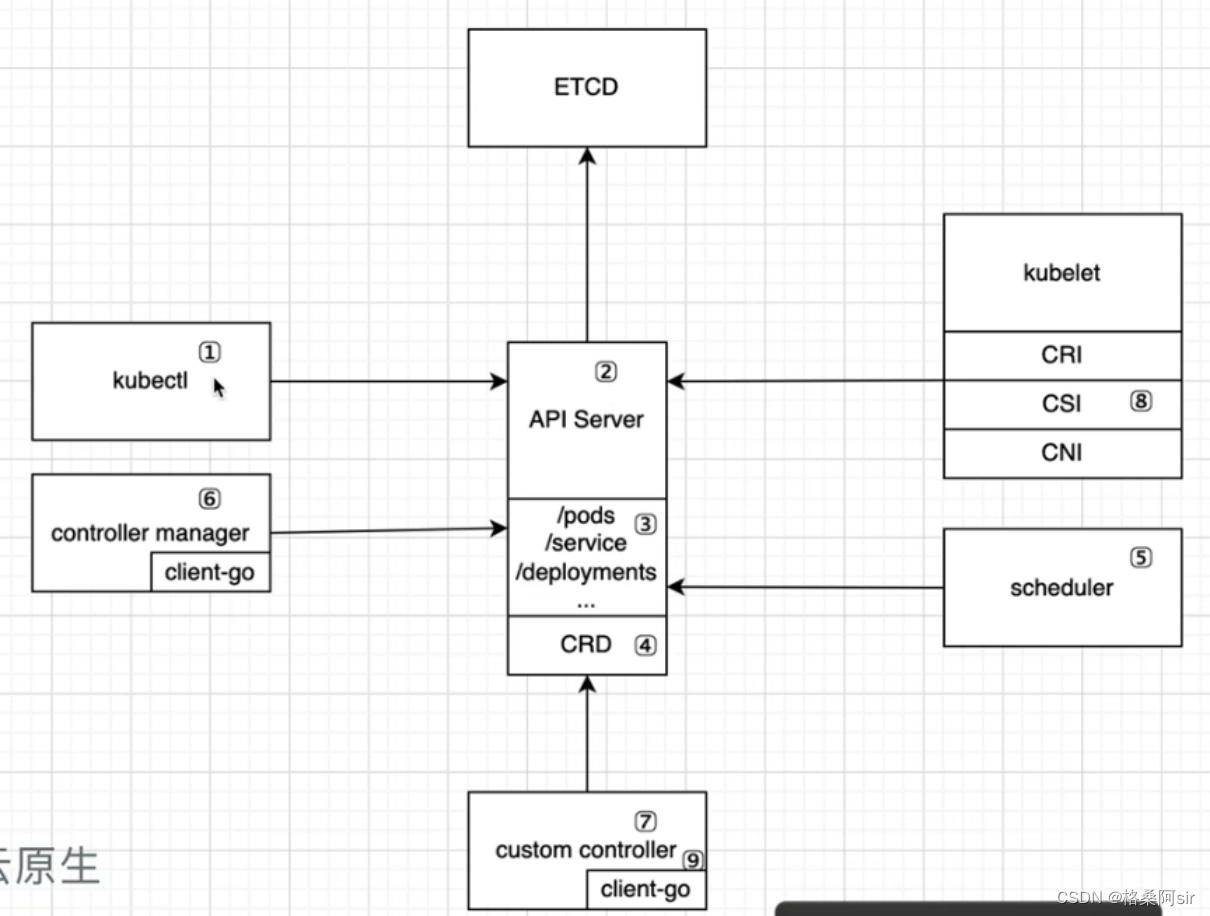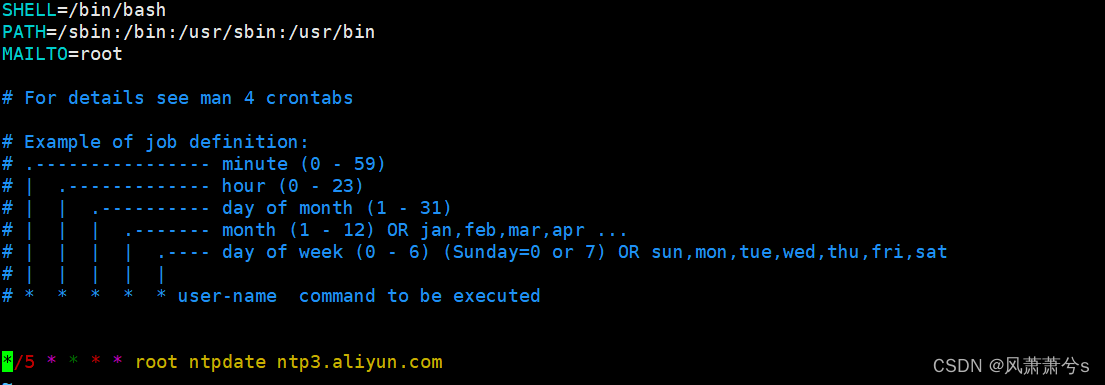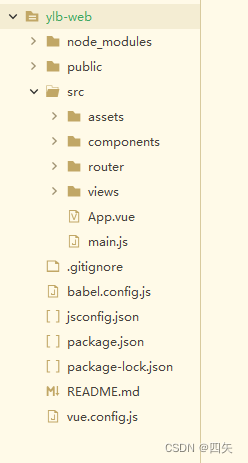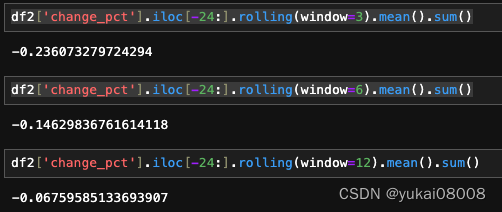学习目标:
博主介绍: 27dCnc
专题 : 数据结构帮助小白快速入门
👍👍👍👍👍👍👍👍👍👍👍👍
☆*: .。. o(≧▽≦)o .。.:*☆
主题: 栈
今日份打卡
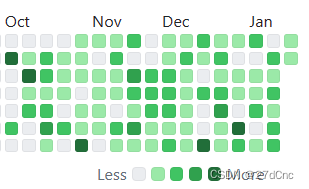
- 代码随想录-栈
学习内容:
- 栈理论基础
- 用栈实现队列
- 用队列实现栈
- 有效的括号
- 删除字符串中的所有相邻重复项
1.栈理论基础
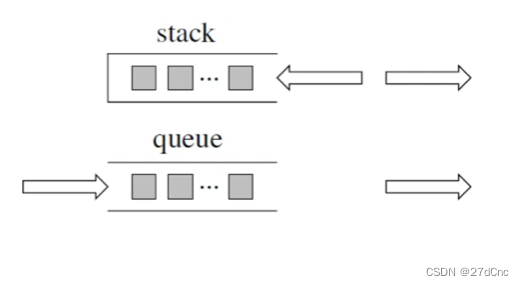
思考:
- C++中stack 是容器么?
- 我们使用的stack是属于哪个版本的STL?
- 我们使用的STL中stack是如何实现的?
- stack 提供迭代器来遍历stack空间么?
首先大家要知道 栈和队列是STL(C++标准库)里面的两个数据结构。
C++标准库是有多个版本的,要知道我们使用的STL是哪个版本,才能知道对应的栈和队列的实现原理。
那么来介绍一下,三个最为普遍的STL版本:
HP STL 其他版本的C++ STL,一般是以HP STL为蓝本实现出来的,HP STL是C++ STL的第一个实现版本,而且开放源代码。
P.J.Plauger STL 由P.J.Plauger参照HP STL实现出来的,被Visual C++编译器所采用,不是开源的。
SGI STL 由Silicon Graphics Computer Systems公司参照HP STL实现,被Linux的C++编译器GCC所采用,SGI STL是开源软件,源码可读性甚高。
接下来介绍的栈和队列也是SGI STL里面的数据结构, 知道了使用版本,才知道对应的底层实现。
来说一说栈,栈先进后出,如图所示:
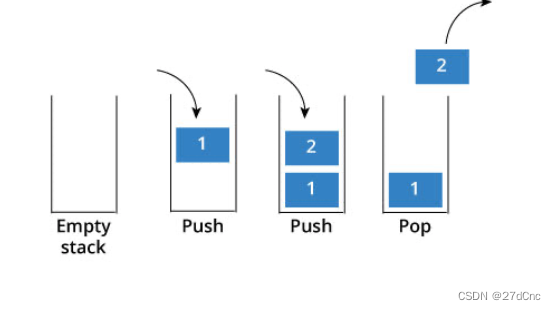
栈提供push 和 pop 等等接口,所有元素必须符合先进后出规则,所以栈不提供走访功能,也不提供迭代器(iterator)。 不像是set 或者map 提供迭代器iterator来遍历所有元素。
栈是以底层容器完成其所有的工作,对外提供统一的接口,底层容器是可插拔的(也就是说我们可以控制使用哪种容器来实现栈的功能)。
所以STL中栈往往不被归类为容器,而被归类为container adapter(容器适配器)。
那么问题来了,STL 中栈是用什么容器实现的?
从下图中可以看出,栈的内部结构,栈的底层实现可以是vector,deque,list 都是可以的, 主要就是数组和链表的底层实现。

我们常用的SGI STL,如果没有指定底层实现的话,默认是以deque为缺省情况下栈的底层结构。
deque是一个双向队列,只要封住一段,只开通另一端就可以实现栈的逻辑了。
SGI STL中 队列底层实现缺省情况下一样使用deque实现的。
232.用栈实现队列
题目
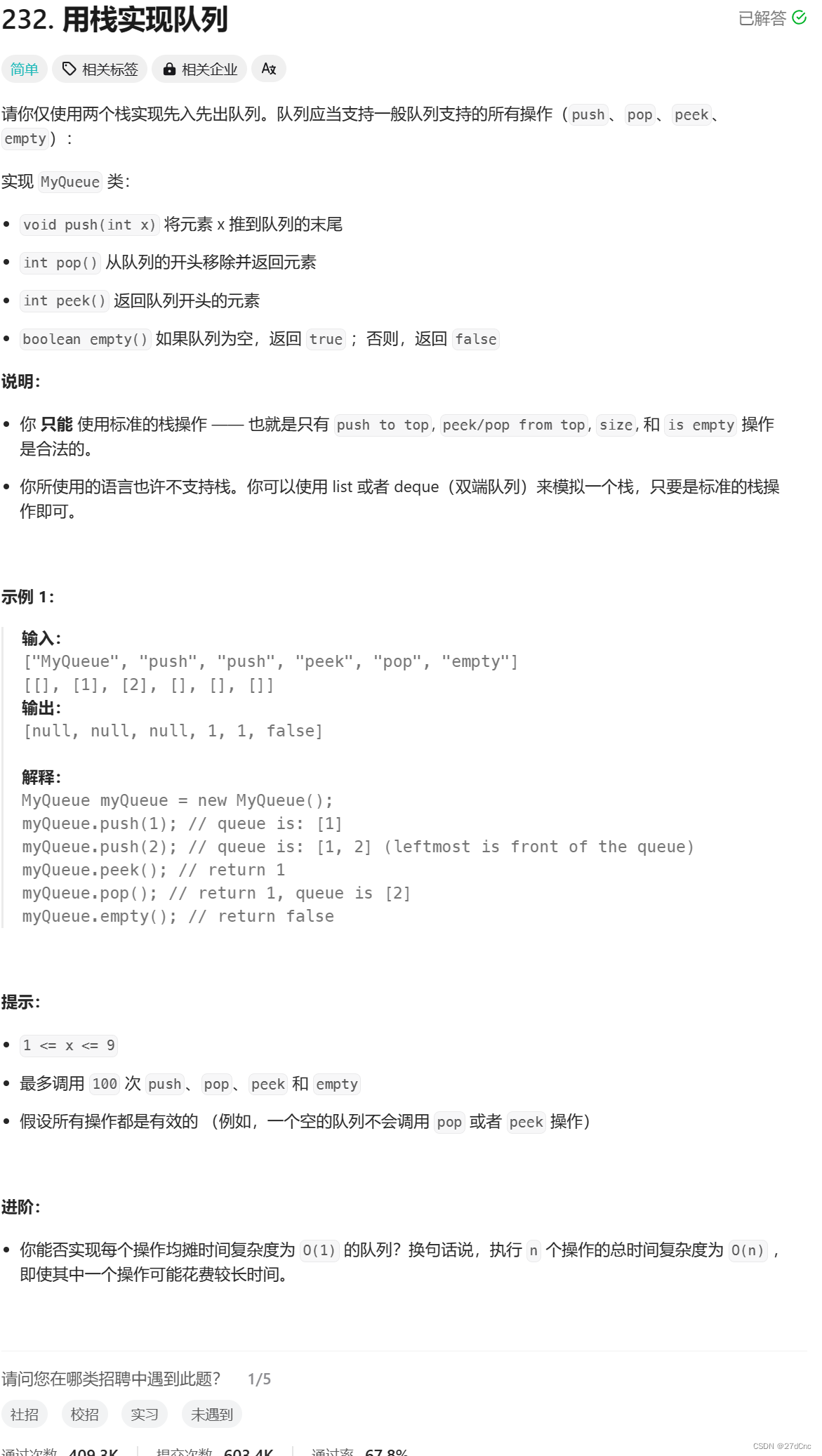
使用栈实现队列的下列操作:
- push(x) – 将一个元素放入队列的尾部。
- pop() – 从队列首部移除元素。
- peek() – 返回队列首部的元素。
- empty() – 返回队列是否为空。
代码
class MyQueue {
public:MyQueue() {}void push(int x) {s.push(x);}int pop() {if(t.empty()&&s.empty()) return -1;if(!t.empty()){//这里s改为tint result = t.top();t.pop();return result;}else{while(!s.empty()){t.push(s.top());//将t的栈顶元素出队列s.pop();//输出s的元素}int result = t.top();t.pop();return result;}}int peek() {if(t.empty()&&s.empty()) return -1;if(!t.empty()){return t.top();}else{while(!s.empty()){t.push(s.top());s.pop();}return t.top();}}bool empty() {if(t.empty()&&s.empty()) return -1;else return 0;}private:stack<int> s;stack<int> t;
};/*** Your MyQueue object will be instantiated and called as such:* MyQueue* obj = new MyQueue();* obj->push(x);* int param_2 = obj->pop();* int param_3 = obj->peek();* bool param_4 = obj->empty();*/
/*** Your MyQueue object will be instantiated and called as such:* MyQueue* obj = new MyQueue();* obj->push(x);* int param_2 = obj->pop();* int param_3 = obj->peek();* bool param_4 = obj->empty();*/
思路 :
这是一道模拟题,不涉及到具体算法,考察的就是对栈和队列的掌握程度。
使用栈来模式队列的行为,如果仅仅用一个栈,是一定不行的,所以需要两个栈一个输入栈,一个输出栈,这里要注意输入栈和输出栈的关系。
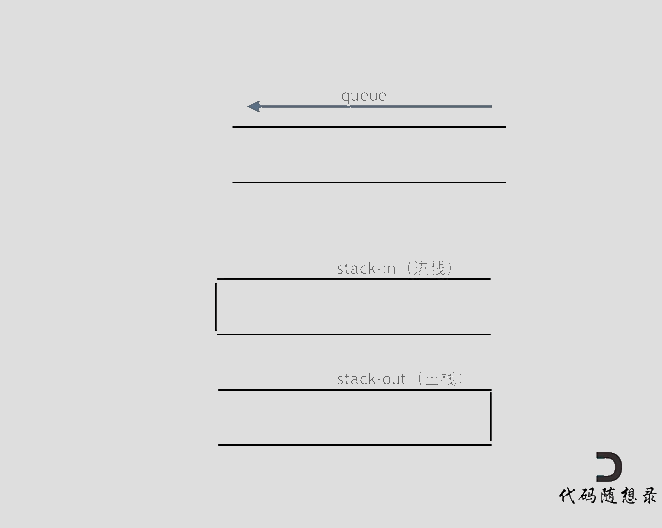
意思就是将元素放在s栈中等到要出队列的时候在移动到t栈中
其他语言
Python
class MyQueue:def __init__(self):"""in主要负责push,out主要负责pop"""self.stack_in = []self.stack_out = []def push(self, x: int) -> None:"""有新元素进来,就往in里面push"""self.stack_in.append(x)def pop(self) -> int:"""Removes the element from in front of queue and returns that element."""if self.empty():return Noneif self.stack_out:return self.stack_out.pop()else:for i in range(len(self.stack_in)):self.stack_out.append(self.stack_in.pop())return self.stack_out.pop()def peek(self) -> int:"""Get the front element."""ans = self.pop()self.stack_out.append(ans)return ansdef empty(self) -> bool:"""只要in或者out有元素,说明队列不为空"""return not (self.stack_in or self.stack_out)
Java
class MyQueue {Stack<Integer> stackIn;Stack<Integer> stackOut;/** Initialize your data structure here. */public MyQueue() {stackIn = new Stack<>(); // 负责进栈stackOut = new Stack<>(); // 负责出栈}/** Push element x to the back of queue. */public void push(int x) {stackIn.push(x);}/** Removes the element from in front of queue and returns that element. */public int pop() { dumpstackIn();return stackOut.pop();}/** Get the front element. */public int peek() {dumpstackIn();return stackOut.peek();}/** Returns whether the queue is empty. */public boolean empty() {return stackIn.isEmpty() && stackOut.isEmpty();}// 如果stackOut为空,那么将stackIn中的元素全部放到stackOut中private void dumpstackIn(){if (!stackOut.isEmpty()) return; while (!stackIn.isEmpty()){stackOut.push(stackIn.pop());}}
}Go
type MyQueue struct {stackIn []int //输入栈stackOut []int //输出栈
}func Constructor() MyQueue {return MyQueue{stackIn: make([]int, 0),stackOut: make([]int, 0),}
}// 往输入栈做push
func (this *MyQueue) Push(x int) {this.stackIn = append(this.stackIn, x)
}// 在输出栈做pop,pop时如果输出栈数据为空,需要将输入栈全部数据导入,如果非空,则可直接使用
func (this *MyQueue) Pop() int {inLen, outLen := len(this.stackIn), len(this.stackOut)if outLen == 0 {if inLen == 0 {return -1}for i := inLen - 1; i >= 0; i-- {this.stackOut = append(this.stackOut, this.stackIn[i])}this.stackIn = []int{} //导出后清空outLen = len(this.stackOut) //更新长度值}val := this.stackOut[outLen-1]this.stackOut = this.stackOut[:outLen-1]return val
}func (this *MyQueue) Peek() int {val := this.Pop()if val == -1 {return -1}this.stackOut = append(this.stackOut, val)return val
}func (this *MyQueue) Empty() bool {return len(this.stackIn) == 0 && len(this.stackOut) == 0
}
225. 用队列实现栈
题目
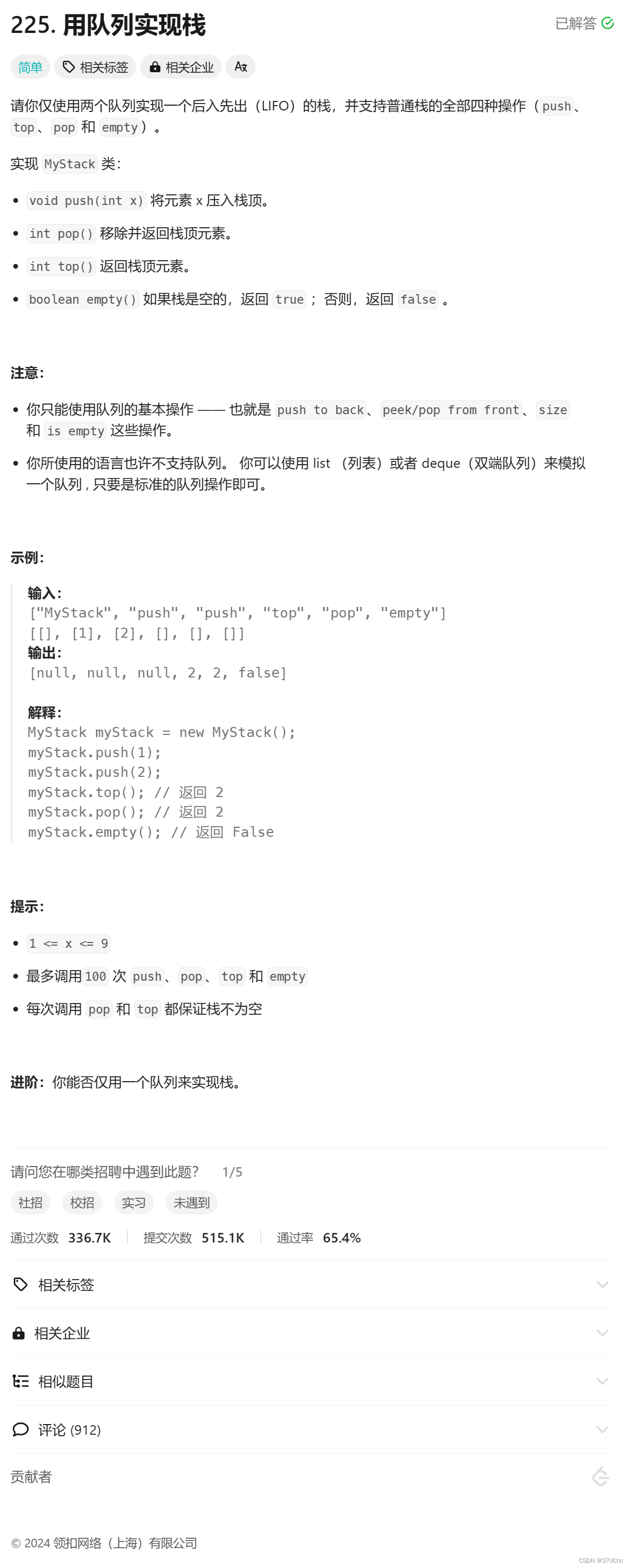
代码
class MyStack {
public:MyStack(){}void push(int x){s.push(x);}//问题是怎么样在第一个队列放一个元素//让元素始终在一个队列中int pop(){int size = s.size();//通过队列长度确定->可以让队列剩下一个元素size--;//留出一个元素空位while(size--){t.push(s.front());//这里将元素放在t队列中s.pop();}int result = s.front();s.pop();//这个时候s为空格s = t;//为什么要讲t赋值给s=>让元素始终在一个栈中?//这里让元素位置复原while(!t.empty()) {t.pop();}return result;}int top(){return s.back();//返回队尾元素}bool empty(){return s.empty();}private:queue<int>s;queue<int>t;
};/*** Your MyStack object will be instantiated and called as such:* MyStack* obj = new MyStack();* obj->push(x);* int param_2 = obj->pop();* int param_3 = obj->top();* bool param_4 = obj->empty();*/
使用队列实现栈的下列操作:
- push(x) – 元素 x 入栈
- pop() – 移除栈顶元素
- top() – 获取栈顶元素
- empty() – 返回栈是否为空
注意:
- 你只能使用队列的基本操作-- 也就是push to back, peek/pop from front, size, 和 is empty 这些操作是合法的。
- 你所使用的语言也许不支持队列。 你可以使用
list或者deque(双端队列)来模拟一个队列 , 只要是标准的队列操作即可。 - 你可以假设所有操作都是有效的(例如, 对一个空的栈不会调用 pop 或者 top 操作)
图解
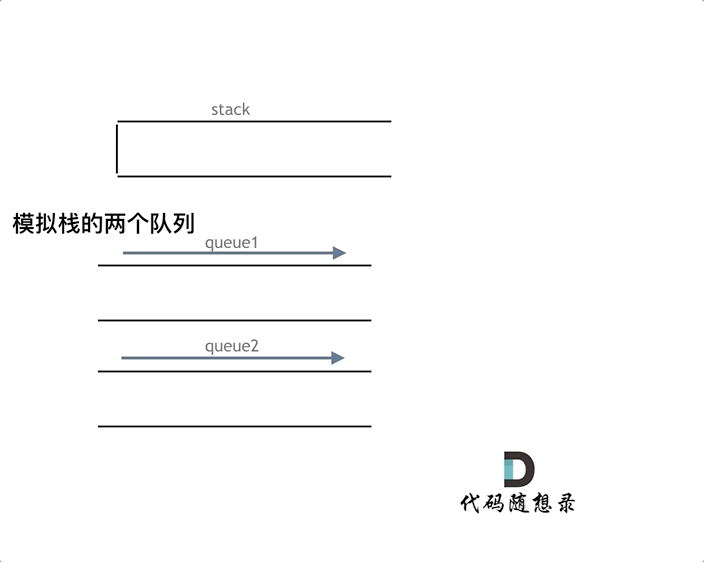
图片解释
- 一个数据入栈就是将元素放在一个队列中
- 然后出栈的时候将元素放在另一个队列中
3.一个用于进元素一个用于出元素
总结
- 面对
栈模拟队列和队列模拟栈都有一个通用思考方式- 一个
队列模拟进栈一个元素模拟出栈- 一个
栈模拟进队一个模拟出队
优化
其实这道题目就是用一个队列就够了。
一个队列在模拟栈弹出元素的时候只要将队列头部的元素(除了最后一个元素外) 重新添加到队列尾部,此时再去弹出元素就是栈的顺序了。
优化代码
class MyStack {
public:queue<int> que;/*第1层*/MyStack() {}/*第2层*/void push(int x) {que.push(x);}/**第3层**/int pop() {int size = que.size();size--;while (size--) { // 将队列头部的元素(除了最后一个元素外) 重新添加到队列尾部que.push(que.front());que.pop();}int result = que.front(); // 此时弹出的元素顺序就是栈的顺序了que.pop();return result;}/**第4层*/int top() {return que.back();}/**第5层*/bool empty() {return que.empty();}
};
其他版本
Python
from collections import dequeclass MyStack:def __init__(self):"""Python普通的Queue或SimpleQueue没有类似于peek的功能也无法用索引访问,在实现top的时候较为困难。用list可以,但是在使用pop(0)的时候时间复杂度为O(n)因此这里使用双向队列,我们保证只执行popleft()和append(),因为deque可以用索引访问,可以实现和peek相似的功能in - 存所有数据out - 仅在pop的时候会用到"""self.queue_in = deque()self.queue_out = deque()def push(self, x: int) -> None:"""直接append即可"""self.queue_in.append(x)def pop(self) -> int:"""1. 首先确认不空2. 因为队列的特殊性,FIFO,所以我们只有在pop()的时候才会使用queue_out3. 先把queue_in中的所有元素(除了最后一个),依次出列放进queue_out4. 交换in和out,此时out里只有一个元素5. 把out中的pop出来,即是原队列的最后一个tip:这不能像栈实现队列一样,因为另一个queue也是FIFO,如果执行pop()它不能像stack一样从另一个pop(),所以干脆in只用来存数据,pop()的时候两个进行交换"""if self.empty():return Nonefor i in range(len(self.queue_in) - 1):self.queue_out.append(self.queue_in.popleft())self.queue_in, self.queue_out = self.queue_out, self.queue_in # 交换in和out,这也是为啥in只用来存return self.queue_out.popleft()def top(self) -> int:"""写法一:1. 首先确认不空2. 我们仅有in会存放数据,所以返回第一个即可(这里实际上用到了栈)写法二:1. 首先确认不空2. 因为队列的特殊性,FIFO,所以我们只有在pop()的时候才会使用queue_out3. 先把queue_in中的所有元素(除了最后一个),依次出列放进queue_out4. 交换in和out,此时out里只有一个元素5. 把out中的pop出来,即是原队列的最后一个,并使用temp变量暂存6. 把temp追加到queue_in的末尾"""# 写法一:# if self.empty():# return None# return self.queue_in[-1] # 这里实际上用到了栈,因为直接获取了queue_in的末尾元素# 写法二:if self.empty():return Nonefor i in range(len(self.queue_in) - 1):self.queue_out.append(self.queue_in.popleft())self.queue_in, self.queue_out = self.queue_out, self.queue_in temp = self.queue_out.popleft() self.queue_in.append(temp)return tempdef empty(self) -> bool:"""因为只有in存了数据,只要判断in是不是有数即可"""return len(self.queue_in) == 0优化
class MyStack:def __init__(self):self.que = deque()def push(self, x: int) -> None:self.que.append(x)def pop(self) -> int:if self.empty():return Nonefor i in range(len(self.que)-1):self.que.append(self.que.popleft())return self.que.popleft()def top(self) -> int:# 写法一:# if self.empty():# return None# return self.que[-1]# 写法二:if self.empty():return Nonefor i in range(len(self.que)-1):self.que.append(self.que.popleft())temp = self.que.popleft()self.que.append(temp)return tempdef empty(self) -> bool:return not self.que
20. 有效的括号
题目
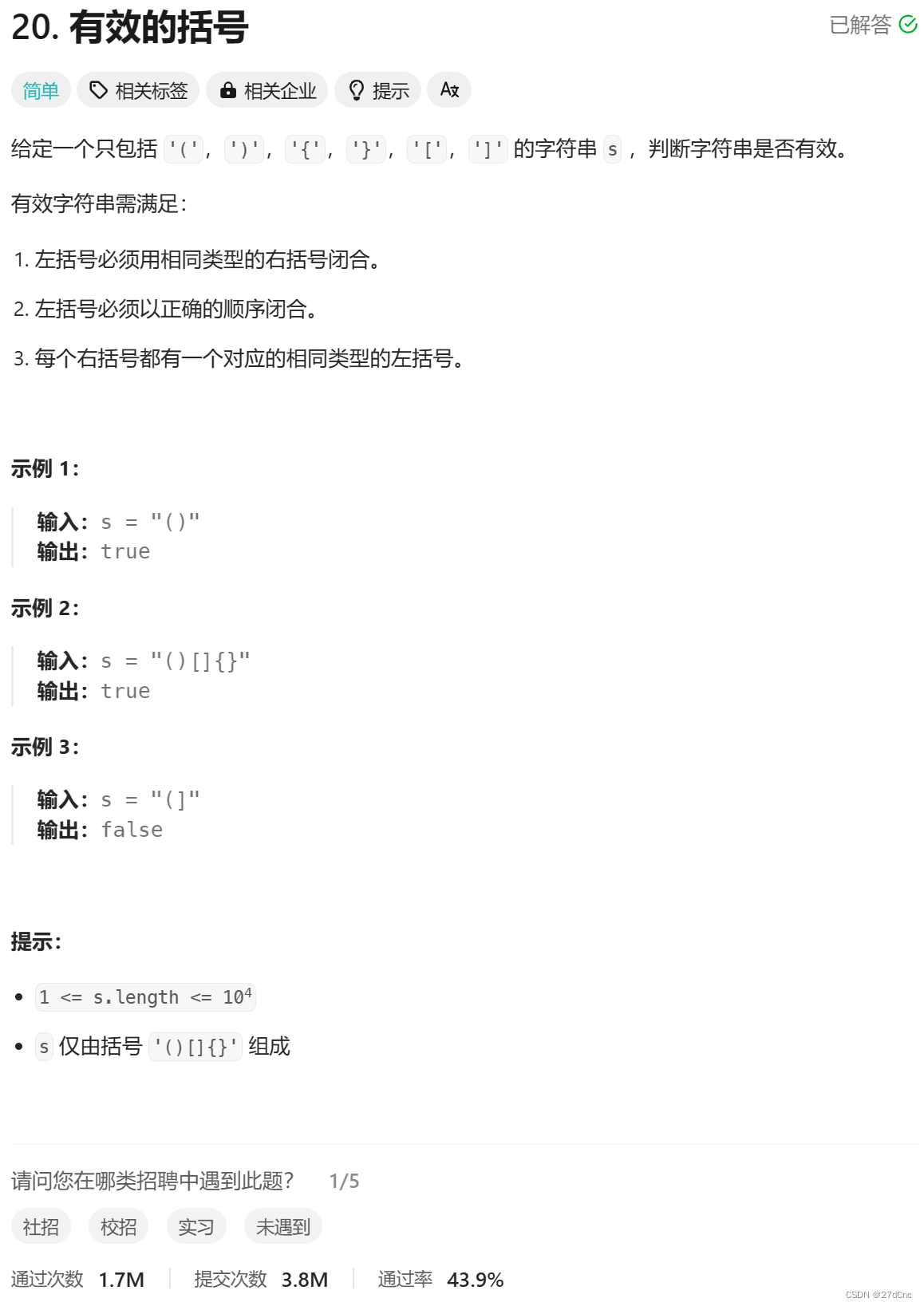
题目分析
** 三种不匹配的情况**
- 第一种情况,字符串里左方向的括号多余了 ,所以不匹配。
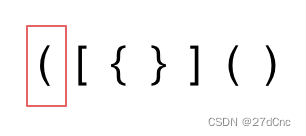
- 第二种情况,括号没有多余,但是 括号的类型没有匹配上。
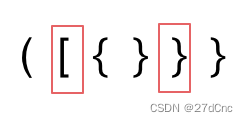
- 第三种情况,字符串里右方向的括号多余了,所以不匹配。
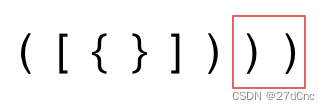
动画如下:
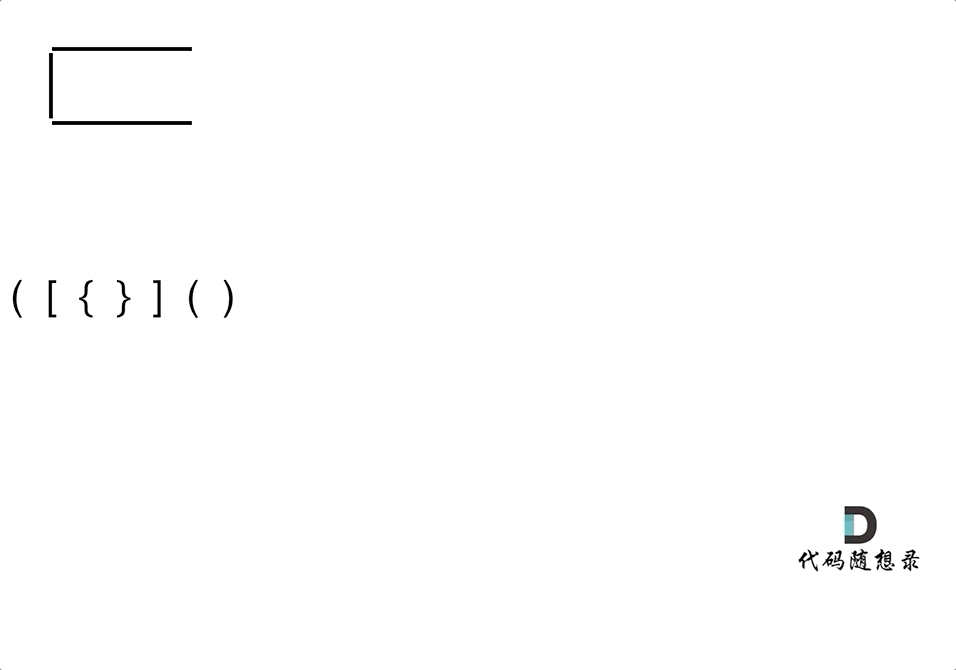
-
第一种情况:已经遍历完了字符串,但是栈不为空,说明有相应的左括号没有右括号来匹配,所以return false
-
第二种情况:遍历字符串匹配的过程中,发现栈里没有要匹配的字符。所以return false
-
第三种情况:遍历字符串匹配的过程中,栈已经为空了,没有匹配的字符了,说明右括号没有找到对应的左括号return false
代码
class Solution {
public:bool isValid(string s) {if(s.size() % 2 != 0) { return false; }stack<char> t;for(int i = 0;i < s.size();i++) { if(s[i] == '(') { t.push(')'); }else if(s[i] == '[') { t.push(']'); }else if(s[i] == '{') { t.push('}'); }else if(t.empty() || s[i] != t.top()) { return 0; }else { t.pop(); }}return t.empty();}
};
注释版
class Solution {
public:bool isValid(string s) {if (s.size() % 2 != 0) return false; // 如果s的长度为奇数,一定不符合要求stack<char> st;for (int i = 0; i < s.size(); i++) {if (s[i] == '(') st.push(')');else if (s[i] == '{') st.push('}');else if (s[i] == '[') st.push(']');// 第三种情况:遍历字符串匹配的过程中,栈已经为空了,没有匹配的字符了,说明右括号没有找到对应的左括号 return false// 第二种情况:遍历字符串匹配的过程中,发现栈里没有我们要匹配的字符。所以return falseelse if (st.empty() || st.top() != s[i]) return false;else st.pop(); // st.top() 与 s[i]相等,栈弹出元素}// 第一种情况:此时我们已经遍历完了字符串,但是栈不为空,说明有相应的左括号没有右括号来匹配,所以return false,否则就return truereturn st.empty();}
};其他版本
Python
class Solution:def isValid(self, s: str) -> bool:stack = []for item in s:if item == '(':stack.append(')')elif item == '[':stack.append(']')elif item == '{':stack.append('}')elif not stack or stack[-1] != item:return Falseelse:stack.pop()return True if not stack else False
Java
class Solution {public boolean isValid(String s) {Deque<Character> deque = new LinkedList<>();char ch;for (int i = 0; i < s.length(); i++) {ch = s.charAt(i);//碰到左括号,就把相应的右括号入栈if (ch == '(') {deque.push(')');}else if (ch == '{') {deque.push('}');}else if (ch == '[') {deque.push(']');} else if (deque.isEmpty() || deque.peek() != ch) {return false;}else {//如果是右括号判断是否和栈顶元素匹配deque.pop();}}//最后判断栈中元素是否匹配return deque.isEmpty();}
}
1047. 删除字符串中的所有相邻重复项
题目

动图
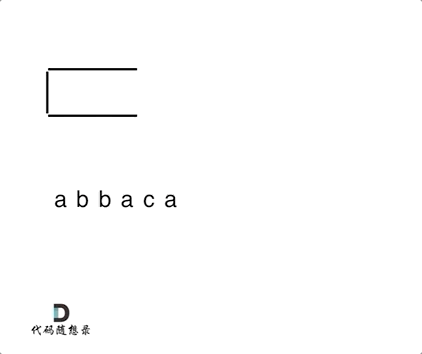
代码
class Solution {
public:string removeDuplicates(string S) {stack<char> st;for (char s : S) {if (st.empty() || s != st.top()) {st.push(s);} else {st.pop(); // s 与 st.top()相等的情况}}string result = "";while (!st.empty()) { // 将栈中元素放到result字符串汇总result += st.top();st.pop();}reverse (result.begin(), result.end()); // 此时字符串需要反转一下return result;}
};
优化
class Solution {
public:string removeDuplicates(string S) {string result;for(char s : S) {if(result.empty() || result.back() != s) {result.push_back(s);}else {result.pop_back();}}return result;}
};
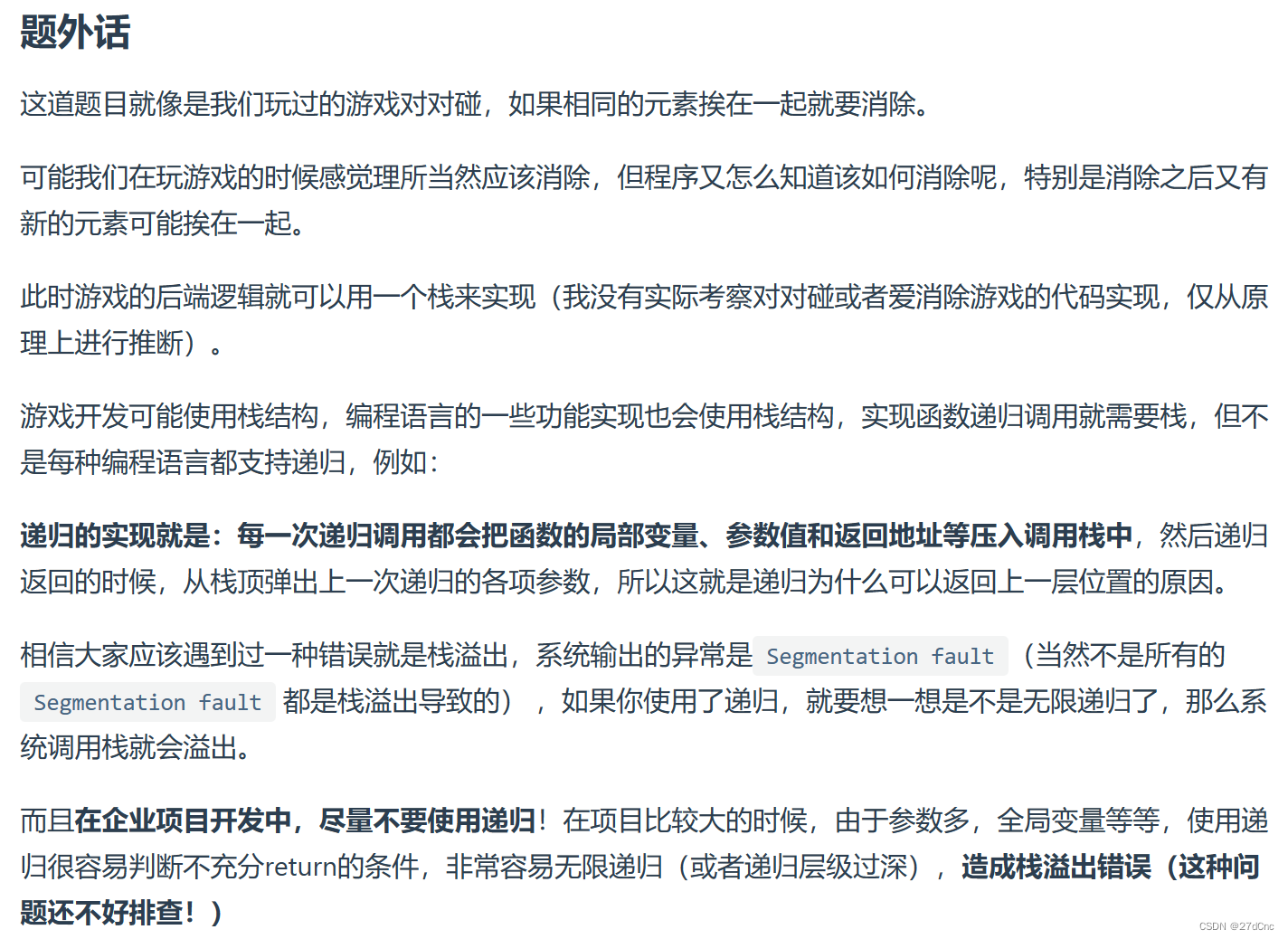
其他版本
Python
1
# 方法一,使用栈
class Solution:def removeDuplicates(self, s: str) -> str:res = list()for item in s:if res and res[-1] == item:res.pop()else:res.append(item)return "".join(res) # 字符串拼接
2
# 方法二,使用双指针模拟栈,如果不让用栈可以作为备选方法。
class Solution:def removeDuplicates(self, s: str) -> str:res = list(s)slow = fast = 0length = len(res)while fast < length:# 如果一样直接换,不一样会把后面的填在slow的位置res[slow] = res[fast]# 如果发现和前一个一样,就退一格指针if slow > 0 and res[slow] == res[slow - 1]:slow -= 1else:slow += 1fast += 1return ''.join(res[0: slow])
Java
class Solution {public String removeDuplicates(String s) {char[] ch = s.toCharArray();int fast = 0;int slow = 0;while(fast < s.length()){// 直接用fast指针覆盖slow指针的值ch[slow] = ch[fast];// 遇到前后相同值的,就跳过,即slow指针后退一步,下次循环就可以直接被覆盖掉了if(slow > 0 && ch[slow] == ch[slow - 1]){slow--;}else{slow++;}fast++;}return new String(ch,0,slow);}
}
学习时间
- 周一至周五晚上 7 点—晚上9点
- 周六上午 9 点-上午 11 点
- 周日下午 3 点-下午 6 点
学习产出
- 技术笔记 2 遍
- CSDN 技术博客 3 篇
- 习的 vlog 视频 1 个
🔥如果此文对你有帮助的话,欢迎💗关注、👍点赞、⭐收藏、✍️评论,支持一下博主~
